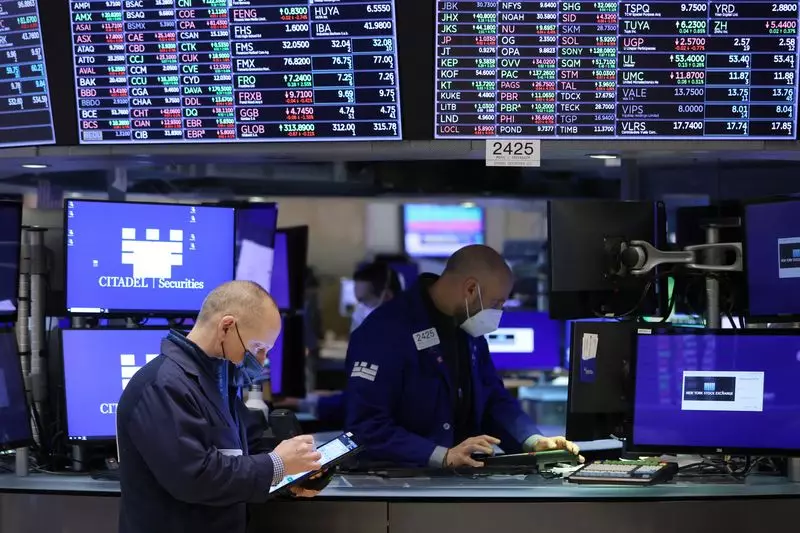The financial markets have exhibited intriguing dynamics recently, marked by fluctuating indexes, corporate earnings announcements, and key economic indicators that prompt a closer examination. As investors navigate these waters, several pivotal events are worth discussing to paint a broader picture of the current fiscal landscape.
On a notable trading day, the S&P 500 index reached an all-time high of 6,128.18 before retracting slightly to a decline of 0.10% by midday. This brief ascent to a record high encapsulates the market’s optimistic streak, although it is essential to understand the underlying factors that contribute to such movements. Investors responded to a mix of encouraging corporate earnings and daunting economic data, illustrating the delicate balance between optimism and caution. Notably, the broader indexes, including the NASDAQ Composite and Dow Jones Industrial Average, followed suit, showing slight decreases of 0.2% and a 0.1% drop, respectively.
The effects of President Donald Trump’s comments at the World Economic Forum in Davos could not be overstated. He communicated intentions to advocate for immediate interest rate reductions, a declaration that sent ripples through the markets, influencing investor sentiment and expectations for future monetary policy. The positive trend observed in major averages indicated that this environment of speculation and anticipation could be leading to a second consecutive week of gains, setting the stage for the evolving market landscape.
Earnings season has a profound impact on stock performance, as illustrated by the mixed responses to quarterly reports from significant corporations. Verizon Communications emerged as a beneficiary, showcasing a robust quarterly wireless subscriber growth rate, which propelled its stock up by over 1%. This surge underscores the company’s resilience in the competitive telecommunications sector.
Contrastingly, American Express faced a downturn, with its stock dropping by 2.4% despite reporting a commendable 12% profit increase in Q4. This anomaly can often occur when market expectations are set too high, suggesting that investors were looking for even more substantial performance during the festive season when spending typically ascends.
Boeing’s scenario highlights the volatile interplay between operational challenges and market perception. With the company anticipating a substantial loss exceeding $4 billion, attributable to a myriad of issues such as labor disputes and government project expenses, it’s clear that external factors can heavily influence stock performance. Such setbacks remind investors of the inherent risks entwined with equity investment.
Technology stocks are often at the forefront of market speculation and growth potential. Twilio’s stocks jolted upwards by an impressive 21% after it provided projections indicating strong earnings and growth potential in its immediate future. This reflects investor confidence in technological innovation that fosters growth. Meta Platforms also experienced a significant uptick, buoyed by its ambitious capital spending plans focused on enhancing AI infrastructure. Their commitment of $60 billion to $65 billion in capital expenditures signals a forward-thinking approach that may yield returns in this rapidly evolving market.
In more niche developments, Intuitive Machines Inc’s contract win from NASA showcases the escalating integration of advanced technology in mainstream industries. Such contracts hint at a burgeoning market for companies involved in aerospace logistics.
Alongside stock movements, economic indicators play a pivotal role in steering market directions. The Michigan Consumer Sentiment Index, which fell to 71.1 in January, represents a warning sign post the prolonged optimism experienced in previous months. A declining sentiment index may indicate rising consumer hesitance or economic disruptions that warrant vigilant monitoring.
In the context of ongoing discussions around interest rate policies, all eyes will be on the upcoming Federal Reserve policy-setting meeting, where the anticipation is a maintenance of the current interest rates despite external pressures. Goldman Sachs analysts have opined that the effects of tariffs introduced during Trump’s tenure are seen as transitory rather than a harbinger of sustained inflation—a perspective likely to curtail any significant interest rate shifts for the time being.
A global financial perspective cannot be overlooked. The Bank of Japan’s recent decision to raise interest rates by 25 basis points, marking its third adjustment since policies tailored away from an ultra-loose stance, echoes a global shift towards tightening monetary policies. This move could influence global capital flows and investor strategies in the near term.
The contemporary market climate showcases a tapestry woven from corporate realities, economic indicators, and monetary policies. Investors remain vigilant, adapting their strategies in light of evolving circumstances, underlining the intricate interplay between various economic factors that collectively shape market dynamics.

